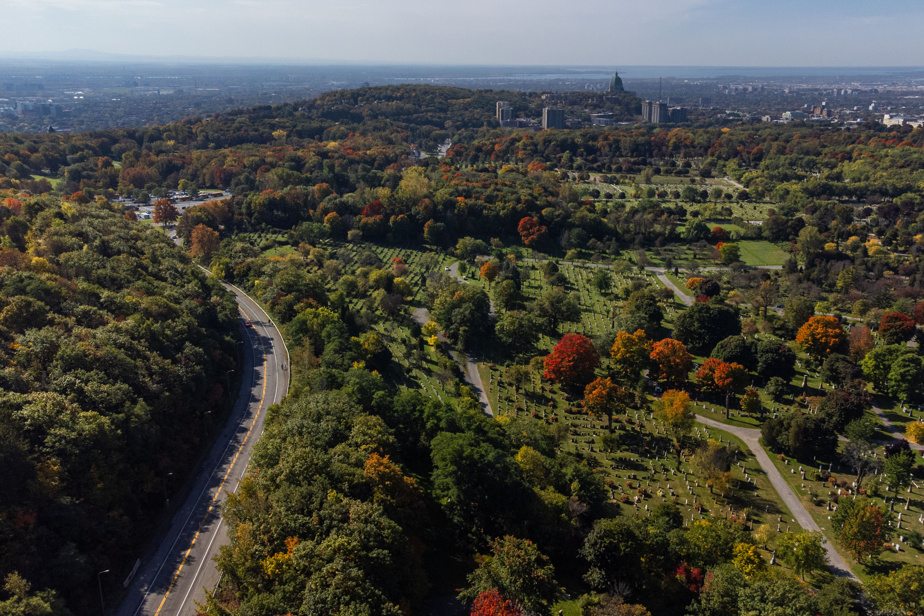A few weeks ago, a few groups of us signed an open letter regarding the critical state of degradation of the natural environments of Mount Royal and the lack of protection of this emblematic place in Montreal.1. This momentum is carried today by a growing number of voices who want immediate and courageous action to ensure the survival of Montreal’s lungs. In our opinion, here are the three priorities on which the City should act now.
Grant a better protection status to Mount Royal
Protecting Mount Royal’s biodiversity is a constant challenge that is far from assured, despite the work of several dedicated players. On the contrary, the incessant automobile traffic, the pollution and the degradation of the natural environments continue to worsen.
Increased protection, supported by science, which makes it possible to measure the integrity of natural environments, accompanied by adequate funding, must be attributed to Mount Royal. The status of protected area, humanized landscape or any other designation that would enhance its environmental protection must be considered and implemented without delay. It is a necessity to preserve the achievements and prevent its protection from being eroded by political changes.
Increase the area of forest cover
Mount Royal’s ecological network must extend to new parcels in order to counterbalance the impacts of climate change. However, currently, the urban forest cover is visibly shrinking. From 2017 to 2019, 764 hectares of forest, the equivalent of approximately 20 La Fontaine parks, disappeared in the greater Montreal area (CMM, 2020). This loss is partly attributable to the lack of adequate protection of the vegetation cover. However, vegetation has a cooling power of up to 4.7°C in urban areas (INSPQ, 2021). It would be ill-advised to do without it when periods of heat wave are more frequent and intense and lead to a 20 to 25% increase in mortality.
Increasing the area of the ecological network, protecting and diversifying habitats and increasing the canopy are becoming real public health issues.
Although the City is on the lookout for opportunities to renaturalize urbanized spaces, in particular by reducing or replacing parking spaces with green spaces, more ambition is needed to maintain the services provided by Mount Royal’s nature. . A multitude of actions are to be considered, including the reduction of the right-of-way of the Camillien-Houde road, the revegetation of clandestine paths and the renaturalization of the Camillien-Houde belvedere.
Improve public transit service and eliminate car crossings
We have been discussing it for 30 years, but never have the circumstances been so critical. All over the world, cities must reduce the space allocated to the car in favor of active and collective transport and safeguard the natural spaces that ensure the well-being of its population.
About 10,000 trips are made daily by car on the mountain, most of them by solo car, with the sole aim of reducing travel time.
This fragmentation of the natural environment affects the beauty of the landscapes, the experience of discovering the mountain, the safety of users (the width of the routes generates speed), the flora and fauna and represents a source of direct pollution which damages the environment. This is why the Camillien-Houde route must be calmed, redeveloped and demineralised as much as possible, along with improved public transit service and better accessibility by active transportation.
Its very existence, in its current state, almost intact since the 1950s, is incompatible with the metropolitan climate plan. The City must not only repair the errors of the past, but show boldness and anticipate the effects of climate change to ensure the health of individuals and the survival of ecosystems in the territory.
When you enter a natural heritage site, you quickly understand that it is an exceptional and precious place. It seems normal that beacons are defined and that a code of conduct applies to anyone who ventures there. Preservation of the environment should be at the heart of the visitor experience and Mount Royal deserves this attention, just like a trip to a national park.
Choices made today will affect our quality of life for decades to come. This is why the time has come to show courage and take the necessary steps.
* Co-signatories: Hélène Panaïotti, General Manager, Les Amis de la montagne; Colleen Thorpe, Executive Director, Equiterre; Alain Branchaud, Director General, Society for Nature and Parks (SNAP); Suzanne Lareau, former President and CEO, Vélo Québec; Laure Waridel, eco-sociologist and co-instigator of Mères au front; Kelly Martin, epidemiologist, emergency physician, and engaged citizen, For Our Kids Montreal; Nathalie Ainsley, co-coordinator, Mothers at the front-Montreal; Jean-François Rheault, President and CEO, Vélo Québec; Cyril Frazao, General Manager, Nature Quebec; Hubert Mansion, vice-president, University in Nature; Jean-Luc Caillaud, General Manager, Rando Quebec; Brice Caillié, General Manager, Network of Protected Natural Environments; Jean-François Boisvert, President, Montreal Climate Coalition; Véronique Fournier, Executive Director, Montreal Urban Ecology Center; Sabaa Khan, Executive Director, David Suzuki Foundation (Quebec); Sandrine Cabana-Degani, General Manager, Piétons Québec; Philippe Meilleur, General Manager, Native Montreal; Rachel Yanchyshyn, Program Manager, Friends of Parks/Park People; Christian Savard, Managing Director, Living in the City; Claudel Pétrin-Desrosiers, President, Quebec Association of Physicians for the Environment; André-Yanne Parent, Executive Director, The Climate Reality Project Canada

